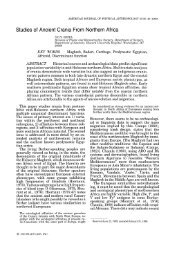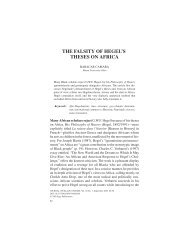Dutch Slavery and Slave Trade in the Indian Ocean
Dutch Slavery and Slave Trade in the Indian Ocean
Dutch Slavery and Slave Trade in the Indian Ocean
You also want an ePaper? Increase the reach of your titles
YUMPU automatically turns print PDFs into web optimized ePapers that Google loves.
152 journal of world history, june 2003<br />
tury emancipation. 49 The authority of <strong>the</strong> Old <strong>and</strong> New Testaments<br />
was supplemented by <strong>the</strong> writ<strong>in</strong>gs of Greco-Roman authors, condon<strong>in</strong>g<br />
slavery “with<strong>in</strong> natural limits” or under certa<strong>in</strong> safeguards stated <strong>in</strong><br />
company ord<strong>in</strong>ances. <strong>Dutch</strong> jurists, such as Hugo Grotius (1583–1645),<br />
recognized voluntary sale <strong>in</strong> order to escape fam<strong>in</strong>e <strong>and</strong> starvation, capture<br />
<strong>in</strong> a just war (bellum iustum), judicial slavery as an alternative to<br />
execution, <strong>and</strong> <strong>in</strong>heritance or birth from a female slave. 50<br />
Whereas ideological motivations on a <strong>the</strong>oretical plane dom<strong>in</strong>ated<br />
discourse <strong>in</strong> Europe, <strong>in</strong> Asia slavery found virtually universal acceptance<br />
on a practical level among self-righteous religious, military, <strong>and</strong><br />
civil officials of <strong>the</strong> <strong>Dutch</strong> East India Company. Us<strong>in</strong>g reasons of state<br />
or pragmatic politics to defend <strong>the</strong> trade, <strong>the</strong>se company servants<br />
ra<strong>the</strong>r opportunistically resorted to a variety of ad hoc arguments <strong>in</strong> an<br />
unsystematic manner. These arguments <strong>in</strong>cluded Christian humanitarian<br />
compassion (sav<strong>in</strong>g <strong>the</strong> body <strong>and</strong> soul of <strong>the</strong> slave), <strong>the</strong> need<br />
to establish <strong>and</strong> populate settlement colonies (“peuplatie”), <strong>the</strong> right<br />
of war <strong>and</strong> conquest (bellum iustum), <strong>the</strong> “uncivilized” nature of <strong>the</strong><br />
“servile” <strong>in</strong>digenous peoples, natural, contractual law (pacta sunct serv<strong>and</strong>a),<br />
<strong>and</strong> f<strong>in</strong>ancial-budgetary considerations (“mesnagie”). To Godfear<strong>in</strong>g<br />
Calv<strong>in</strong>ists <strong>in</strong> patria <strong>and</strong> overseas, <strong>the</strong> enslavements of African<br />
<strong>and</strong> Asian peoples did create a serious moral predicament for both<br />
opponents <strong>and</strong> apologists alike. Torn between ga<strong>in</strong> <strong>and</strong> godl<strong>in</strong>ess, or<br />
<strong>the</strong> practical temptations of <strong>the</strong> “<strong>Dutch</strong> trad<strong>in</strong>g empire” <strong>and</strong> <strong>the</strong> pr<strong>in</strong>ciple<br />
requirements of <strong>the</strong> “Empire of Christ,” <strong>the</strong> “peculiar <strong>in</strong>stitution”<br />
was carefully circumscribed, permissible only “for good <strong>and</strong> sufficient<br />
49 G. Groenhuis, “Zonen van Cham,” Kleio 21 (1980):224; G. J. Schutte, “Bij het<br />
Schemerlicht van Hun Tijd: Zeventiende-Eeuwse Gereformeerden en de <strong>Slave</strong>nh<strong>and</strong>el,” <strong>in</strong><br />
M. Bruggeman et al., eds., Mensen van de Nieuwe Tijd: Een Liber Amoricum voor A. Th. Van<br />
Deursen (Amsterdam, 1996), pp. 193–217; P. C. Emmer, De Nederl<strong>and</strong>se <strong>Slave</strong>nh<strong>and</strong>el,<br />
1500–1850 (Amsterdam <strong>and</strong> Antwerp, 2000), pp. 30–39; L. R. Priester, De Nederl<strong>and</strong>se<br />
Houd<strong>in</strong>g ten Aanzien van de <strong>Slave</strong>nh<strong>and</strong>el en <strong>Slave</strong>rnij, 1596–1863: Het Gedrag van de <strong>Slave</strong>nh<strong>and</strong>elaren<br />
van de Commercie Compagnie van Middelburg <strong>in</strong> de 18de Eeuw (Middelburg, 1987),<br />
pp. 43, 74 n. 28. See also S. R. Haynes, Noah’s Curse: The Biblical Justification of American<br />
<strong><strong>Slave</strong>ry</strong> (New York, 2001); B. Braude, “The Sons of Noah <strong>and</strong> <strong>the</strong> Construction of Ethnic<br />
<strong>and</strong> Geographical Identities <strong>in</strong> <strong>the</strong> Medieval <strong>and</strong> Early Modern Periods,” William <strong>and</strong> Mary<br />
Quarterly, 3rd series, 54 (January 1997):103–42; W. McKee Evans, “From <strong>the</strong> L<strong>and</strong> of<br />
Canaan to <strong>the</strong> L<strong>and</strong> of Gu<strong>in</strong>ea or <strong>the</strong> Strange Odyssey of <strong>the</strong> Sons of Ham,” American Historical<br />
Review 85, no. 1 (February 1980):15–43; M. Adhikari, “The Sons of Ham: <strong><strong>Slave</strong>ry</strong><br />
<strong>and</strong> <strong>the</strong> Mak<strong>in</strong>g of Coloured Identity,” South African Historical Journal 27 (1992):95–112.<br />
For an <strong>in</strong>terest<strong>in</strong>g discussion of <strong>the</strong> “Ham ideology,” see Valentijn, Oud- en Nieuw Oost-<br />
Indiën II, pp. 371–72.<br />
50 H. Grotius, The Law of War <strong>and</strong> Peace: De Jure Belli ac Pacis Libri Tres, F. Kelsey,<br />
trans., J. Brown Scott, ed. (<strong>Indian</strong>apolis <strong>and</strong> New York, 1925), pp. 255–59, 690–91, 718,<br />
761–69.




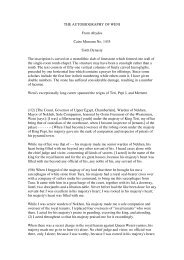
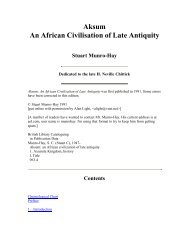
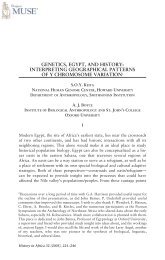

![The Negro trail blazers of California [microform] : a ... - Homestead](https://img.yumpu.com/32436613/1/174x260/the-negro-trail-blazers-of-california-microform-a-homestead.jpg?quality=85)

